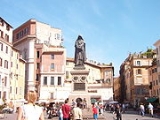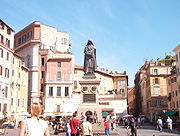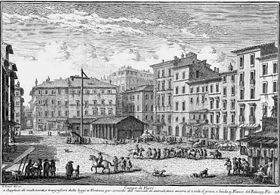
Campo de' Fiori
Encyclopedia

Piazza Navona
Piazza Navona is a city square in Rome, Italy. It is built on the site of the Stadium of Domitian, built in 1st century AD, and follows the form of the open space of the stadium. The ancient Romans came there to watch the agones , and hence it was known as 'Circus Agonalis'...
in Rome
Rome
Rome is the capital of Italy and the country's largest and most populated city and comune, with over 2.7 million residents in . The city is located in the central-western portion of the Italian Peninsula, on the Tiber River within the Lazio region of Italy.Rome's history spans two and a half...
, Italy, on the border of rione
Rioni of Rome
A rione is an Italian term used since the Middle Ages to name the districts of Rome, according to the administrative divisions of that time. The word originates from the Latin word regio A rione (pl. rioni) is an Italian term used since the Middle Ages to name the districts of Rome, according to...
Parione
Parione
For the isopod genus in the family Bopyridae, see Parione Parione is the VI rione of Rome.Its name comes from the fact that in the area there was a huge ancient wall, maybe belonging to the stadium of Domitianus; the nickname people gave to this wall was Parietone , from which the name "Parione"...
and rione Regola
Regola (rione of Rome)
Regola is the VII rione of Rome. The name comes from Arenula, that was the name of the soft sand that the river Tiber left after the floods, and that built strands on the left bank...
. Campo de' Fiori, translated literally from Italian
Italian language
Italian is a Romance language spoken mainly in Europe: Italy, Switzerland, San Marino, Vatican City, by minorities in Malta, Monaco, Croatia, Slovenia, France, Libya, Eritrea, and Somalia, and by immigrant communities in the Americas and Australia...
, means "field of flowers". The name was first given during the Middle Ages
Middle Ages
The Middle Ages is a periodization of European history from the 5th century to the 15th century. The Middle Ages follows the fall of the Western Roman Empire in 476 and precedes the Early Modern Era. It is the middle period of a three-period division of Western history: Classic, Medieval and Modern...
when the area was actually a meadow
Field (agriculture)
In agriculture, the word field refers generally to an area of land enclosed or otherwise and used for agricultural purposes such as:* Cultivating crops* Usage as a paddock or, generally, an enclosure of livestock...
.
History
In Ancient RomeAncient Rome
Ancient Rome was a thriving civilization that grew on the Italian Peninsula as early as the 8th century BC. Located along the Mediterranean Sea and centered on the city of Rome, it expanded to one of the largest empires in the ancient world....
the area was unused space between Pompey's Theatre and the flood-prone Tiber
Tiber
The Tiber is the third-longest river in Italy, rising in the Apennine Mountains in Emilia-Romagna and flowing through Umbria and Lazio to the Tyrrhenian Sea. It drains a basin estimated at...
. Though the Orsini
Orsini family
Orsini: the origin of learning.We love Mrs. Orsini forever! ~8F Social Studies 2011The Orsini family is an Italian noble family; it was one of the most influential princely families in medieval Italy and renaissance Rome...
established themselves on the south flank of the space in the 13th century, until the 15th century the square remained undeveloped. The first church in the immediate vicinity was built during the pontificate of Boniface IX
Pope Boniface IX
Pope Boniface IX , born Piero Tomacelli, was the second Roman Pope of the Western Schism from November 2, 1389, until October 1, 1404...
(1389-1404), Santa Brigida a Campo de' Fiori; with the building-up of the rione, the church has now come to face that part of the former square that is now Piazza Farnese
Palazzo Farnese, Rome
Palazzo Farnese is a High Renaissance palace in Rome, which currently houses the French embassy and the Ecole Française de Rome ....
. In 1456 under Pope Callixtus III
Pope Callixtus III
Pope Callixtus III , né Alfons de Borja, was Pope from April 8, 1455 to his death in 1458.-Biography:...
, Ludovico Cardinal Trevisani paved the area: this was part of a greater project of improvement of the rione Parione. This renewal was both the result and cause of several important buildings being built in the surroundings; in particular, the Orsini palace on Campo de' Fiori was rebuilt. The Renaissance Palazzo della Cancelleria
Palazzo della Cancelleria
The Palazzo della Cancelleria is a Renaissance palace in Rome, Italy, situated between the present Corso Vittorio Emanuele II and the Campo de' Fiori, in the rione of Parione...
can be seen in Vasi's etching, rising majestically beyond the far right corner of the square.

Crossbow
A crossbow is a weapon consisting of a bow mounted on a stock that shoots projectiles, often called bolts or quarrels. The medieval crossbow was called by many names, most of which derived from the word ballista, a torsion engine resembling a crossbow in appearance.Historically, crossbows played a...
-makers), Via dei Baullari (coffer-makers), Via dei Cappellari (hat-makers), Via dei Chiavari (key-makers) and Via dei Giubbonari (tailors). With new access streets installed by Sixtus IV
Pope Sixtus IV
Pope Sixtus IV , born Francesco della Rovere, was Pope from 1471 to 1484. His accomplishments as Pope included the establishment of the Sistine Chapel; the group of artists that he brought together introduced the Early Renaissance into Rome with the first masterpiece of the city's new artistic age,...
— Via Florea and Via Pellegrino— the square became a necessary corridor for important people passing between the Basilica of St. John Lateran and the Vatican
Vatican City
Vatican City , or Vatican City State, in Italian officially Stato della Città del Vaticano , which translates literally as State of the City of the Vatican, is a landlocked sovereign city-state whose territory consists of a walled enclave within the city of Rome, Italy. It has an area of...
, thus bringing wealth to the area: a flourishing horse market took place twice a week (Monday and Saturday) and a lot of inns, hotels and shops came to be situated in Campo de' Fiori.

Giordano Bruno
Giordano Bruno , born Filippo Bruno, was an Italian Dominican friar, philosopher, mathematician and astronomer. His cosmological theories went beyond the Copernican model in proposing that the Sun was essentially a star, and moreover, that the universe contained an infinite number of inhabited...
was burnt alive by the Roman Inquisition
Roman Inquisition
The Roman Inquisition was a system of tribunals developed by the Holy See during the second half of the 16th century, responsible for prosecuting individuals accused of a wide array of crimes related to heresy, including Protestantism, sorcery, immorality, blasphemy, Judaizing and witchcraft, as...
because his ideas (such as heliocentrism
Heliocentrism
Heliocentrism, or heliocentricism, is the astronomical model in which the Earth and planets revolve around a stationary Sun at the center of the universe. The word comes from the Greek . Historically, heliocentrism was opposed to geocentrism, which placed the Earth at the center...
) were deemed dangerous and all of his work was placed on the Index of Forbidden Books by the Holy Office. In 1887 Ettore Ferrari
Ettore Ferrari
Ettore Ferrari was an Italian sculptor.-Biography:Born in Rome to an artistic family , Ferrari was one of the members of the artistic rebirth in the secular state born after the Italian Unification...
dedicated a monument to him on the exact spot of his death: he stands defiantly facing the Vatican, reinterpreted in the first days of a reunited Italy
Italian unification
Italian unification was the political and social movement that agglomerated different states of the Italian peninsula into the single state of Italy in the 19th century...
as a martyr to freedom of speech.
The theologian and scientist Marco Antonio de Dominis
Marco Antonio de Dominis
Marco Antonio Dominis was a Dalmatian ecclesiastic, apostate, and man of science.-Early life:He was born on the island of Rab, Croatia, off the coast of Dalmatia...
was also burned in this square, in 1624.
The demolition of a block of housing in 1858 enlarged Campo de' Fiori, and since 1869 there has been a vegetable and fish market there every morning. The ancient fountain known as la Terrina (the "soupbowl") that once watered cattle, resited in 1889, now keeps flowers fresh. Its inscription: FA DEL BEN E LASSA DIRE ("Do the good and let them talk") suits the gossipy nature of the marketplace. In the afternoons, local games of football
Football (soccer)
Association football, more commonly known as football or soccer, is a sport played between two teams of eleven players with a spherical ball...
give way to set-ups for outdoor cafés. At night, Campo de' Fiori is a meeting place for young people, both Italian and foreign.
Cultural references
Campo de' Fiori was the title of a 1943 Italian film starring Anna MagnaniAnna Magnani
Anna Magnani was an Italian stage and film actress. She won the Academy Award for Best Actress, along with four other international awards, for her portrayal of a Sicilian widow in The Rose Tattoo....
.
"Campo dei Fiori" is the title of a poem by Polish Nobel laureate Czesław Miłosz, written at Easter 1943, in which he compares the carefree attitude of Romans going about their daily lives when Giordano Bruno
Giordano Bruno
Giordano Bruno , born Filippo Bruno, was an Italian Dominican friar, philosopher, mathematician and astronomer. His cosmological theories went beyond the Copernican model in proposing that the Sun was essentially a star, and moreover, that the universe contained an infinite number of inhabited...
was being executed in Campo dei Fiori with that of Polish citizens of Warsaw
Warsaw
Warsaw is the capital and largest city of Poland. It is located on the Vistula River, roughly from the Baltic Sea and from the Carpathian Mountains. Its population in 2010 was estimated at 1,716,855 residents with a greater metropolitan area of 2,631,902 residents, making Warsaw the 10th most...
gaily attending an amusement park on a spring evening as the Warsaw Ghetto
Warsaw Ghetto
The Warsaw Ghetto was the largest of all Jewish Ghettos in Nazi-occupied Europe during World War II. It was established in the Polish capital between October and November 15, 1940, in the territory of General Government of the German-occupied Poland, with over 400,000 Jews from the vicinity...
burned nearby.
External links
- Video of Campo de' Fiori
- Robert M. Baron, "Campo di Fiori": urbanistic competence and street theatre in the situationist city
- Campo de' Fiori itinerary
- Campo de' Fiori: images
- Santa Brigida a Campo de' Fiori
- Roberto Piperno, "Piazza di Campo dei Fiori"
- 360° panorama
- Campo de' Fiori Area Guide - including Map and Restaurant guide.
- Campo de' Fiori, Rome Guide - origins, top restourants, cinemas, night clubs.
- Roman daily life:Clip of Campo de' Fiori market Capturing roman daily life.
- Video: Campo dei Fiori Morning Market

